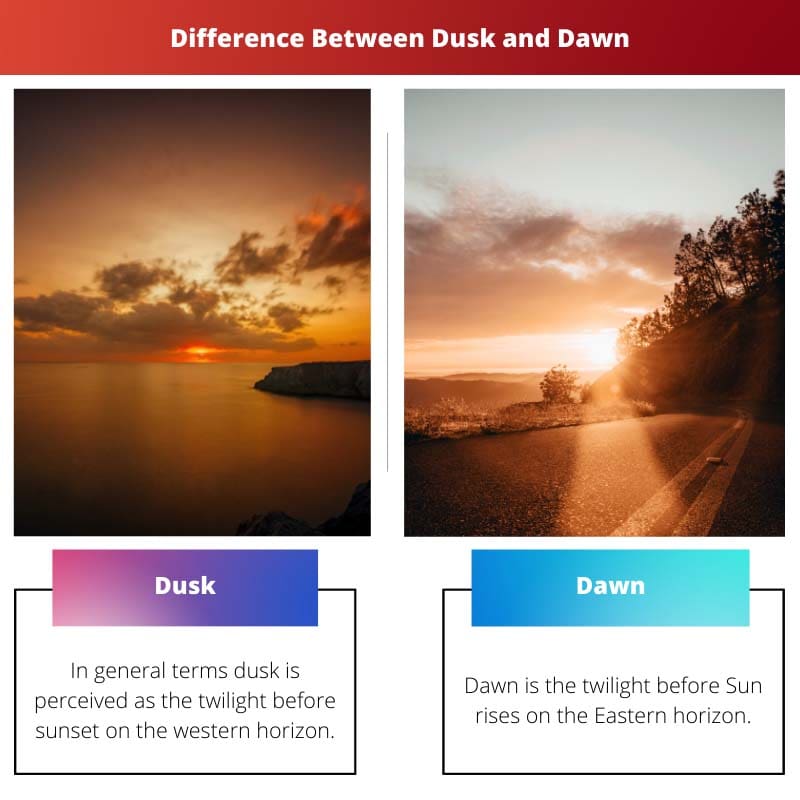Twilights are crucial for the Military, Navy and Aviation industry, and they use specific terms such as BMNT and EENT to define and set rules for strategically important decisions. But for the common man, the simplest terms dusk and dawn can be confusing.
Key Takeaways
- Dusk is the period between the evening and night when the sun is below the horizon, and the sky gradually darkens.
- Dawn is the period between night and morning when the sun is below the horizon, and the sky gradually brightens.
- Both dusk and dawn are transitional periods between day and night, but they occur at opposite times, with dusk marking the onset of night and dawn heralding the arrival of morning.
Dusk vs Dawn
The difference between dusk and dawn is that dusk is the twilight before Sunset on the West, and dawn is the twilight before the Sun rises on the East horizon.

However, there are three types of twilight based on the sun’s angle on the horizon. These are civil twilight, nautical twilight and astronomical twilight.
Considering this, dusk and dawn have a list of differences that must be noted while making this list. Such as for civil twilight, dusk is when the Sun is 6 degrees below the horizon before sunset in the evening, whereas dawn is when the same situation arises in the morning.
In the case of nautical twilight, the difference between dusk and dawn is when the geometric centre of the Sun is 12 degrees below the horizon in the evening, it is dusk, while dawn is the same but in the morning before sunrise.
Comparison Table
| Parameter of Comparison | Dusk | Dawn |
|---|---|---|
| By definition | It is the twilight before sunset | It is the twilight before sunrise |
| Civil twilight specification | When the Sun is 6 degrees below the horizon before sunrise | When the Sun is 6 degrees below the horizon before sunset |
| Nautical twilight specification | When the Sun is 12 degrees below the horizon in the evening | When the Sun is 12 degrees below the horizon in the morning |
| Astronomical twilight specification | When the Sun is 18 degrees below the horizon in the evening | When the sun is 18 degrees below the horizon before sunrise. |
| Polar twilight | Polar dusk, Begins after the September equinox and lasts for a few days | Polar dawn begins a few days before the March equinox |
What is Dusk?
In general terms, dusk is perceived as the twilight before sunset on the western horizon. This is the time that marks the end of the daylight and the beginning of the dark hours.
This transition phase receives dim sunlight, and often, the sky is masked with beautiful colours that are formed while the last of the sunrays plays reflection games with the varied particles of the atmospheric layers.
However, several technical specifications define dusk in the civil, nautical and astronomical twilight definitions.
The civil dusk is when the geographic centre of the sun is 6 degrees below the horizon, while the nautical dusk is when the sun is 12 degrees below the horizon. However, the astronomical dusk finally marks the end of the day.
It is when the sun is 18 degrees below the horizon, and no sunlight is visible beyond this. The end of astronomical dusk marks the end of the sunset.
Further, dusk is shorter in the tropical and equator region, while it is longer as we go towards higher latitudes. Polar dusk remains for the longest time.
It begins at the September equinox and stretches for a few days before the sun sets for six months and complete darkness prevails.

What is Dawn?
Dawn is the twilight before Sun rises on the Eastern horizon. The sky is coloured in a light orange and red hue during this time, marking the beginning of daylight.
The complete sunrise marks the end of dawn. However, the phases of dawn are separated based on the degree of angle of the sun’s geometric centre with the horizon.
Civil dawn is when the sun’s geometric centre is 6 degrees below the horizon, and nautical dawn is when it is 12 degrees below the horizon. Astronomical dawn is when the Sun is 18 degrees below the horizon.
Astronomical dawn begins the morning twilight, followed by nautical and civil twilight, which ends with complete sunrise. The length of dawn to depends upon the latitude and longitude of the place.
Dawn in the equator and tropics are shorter than in higher latitudes.
Dawn prevails for the longest time in the extremes but only once a year. The polar dawn begins a few days before the March equinox and marks the beginning of the daylight days in the poles.

Main Differences Between Dusk and Dawn
- The main difference between dusk and dawn is that dusk is the twilight before Sun sets on the West, and dawn is the twilight before the Sun rises on the East horizon.
- Civil dusk is when the Sun is 6 degrees below the horizon before sunset in the evening, whereas civil dawn is when the same situation arises in the morning.
- The difference between nautical and nautical dawn is when the Sun is 12 degrees below the horizon in the evening, it is nautical dusk, while nautical dawn is the same but in the morning.
- Astronomical dusk is when the sun is 18 degrees below the horizon in the evening, whereas dawn is when it is 18 degrees below the horizon in the morning.
- A polar dusk begins at the September equinox, whereas a polar dawn ends at the March equinox.


I found the article’s comparison of dusk and dawn quite enlightening.
Agreed, Jacob. The article makes it easy to comprehend the differences between the twilights.
The dimensions about how duration of twilight varies in different parts of the world are eye-opening.
Couldn’t agree more, Dominic. It’s remarkable how twilights are experienced differently depending on location.
An excellent explanation of the technical specifications of dusk and dawn.
Well said, Brown Owen. The technical details are incredibly precise and fascinating.
I found the explanation on the different types of twilight highly informative.
Absolutely, Vanessa. The different types of twilight can be quite confusing, but the article explains it all so well.
This article really highlights the intricacies of twilights and their differences.
Absolutely, Beth. The details in the article are quite enlightening.
The article on twilights are absolutely fascinating! It provides a comprehensive explanation of what is considered a simple concept.
I completely agree, Jamie. It’s amazing how different definitions and specifics are required across different regions.
I love the comparison table! It truly makes it easier to understand the differences between dusk and dawn in one place.
The details about the transition from twilight to darkness and from twilight to daylight are intriguing.
Absolutely, Charlotte. The intricacies of these transitions are quite captivating.
I found the description about the civil, nautical, and astronomical twilight illuminating.
I agree, Dominic. The distinctions make a significant difference in how we perceive twilights.
The length of dawn and dusk based on latitude and longitude was quite interesting to learn.
Agreed, Jim31. It’s incredible how location affects twilight duration.
I had no idea about these differences. A fantastic revelation!
It’s astonishing how much detail goes into specifying different twilights. A fascinating read.
The point about polar dawn and polar dusk is particularly interesting.
Indeed, Ppalmer. I had no idea so many factors are involved in the definition of dusk and dawn.